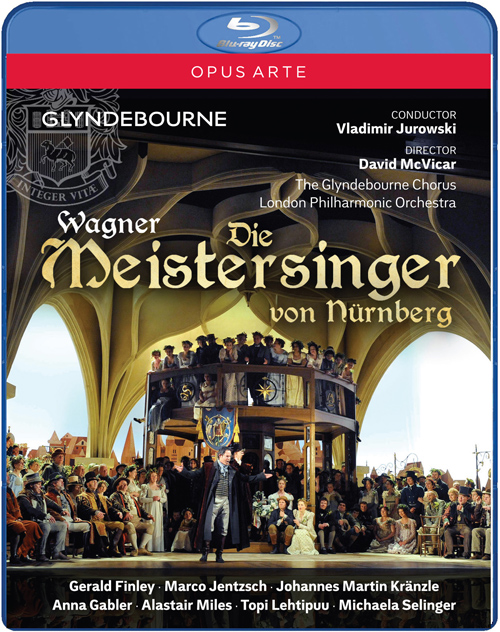WAGNER, R.: Meistersinger von Nürnberg (Die) (Glyndebourne, 2011) (Blu-ray, HD)
Richard Wagner
DIE MEISTERSINGER VON NÜRNBERG
(Blu-ray Disc Version)
Walther von Stolzing – Marco Jentzsch
Eva – Anna Gabler
Magdalene – Michaela Selinger
David – Topi Lehtipuu
Veit Pogner – Alastair Miles
Sixtus Beckmesser – Johannes Martin Kränzle
Hans Sachs – Gerald Finley
Kunz Vogelgesang – Colin Judson
The Glyndebourne Chorus
London Philharmonic Orchestra
Vladimir Jurowski, conductor
David McVicar, stage director
Recorded live at Glyndebourne, Lewes, July 2011
Picture format: 1080i High Definition
Sound format: LPCM 2.0 / DTS 5.1
Region code: 0 (worldwide)
Subtitles: English, French, German
Running time: 300 mins
No. of Discs: 1 (Blu-ray)
Note: This Blu-ray Disc is only playable on Blu-ray Disc players and not compatible with standard DVD players

Wagner was a remarkable innovator in both the harmony and structure of his work, stressing his own concept of the Gesamtkunstwerk, the ‘total work of art’, in which all the arts were brought together into a single unity. He was prepared to sacrifice his family and friends in the cause of his own music, and his overt anti-Semitism has attracted unwelcome attention to ideas that are remote from his real work as a musician. In the later part of his career Wagner enjoyed the support of King Ludwig II of Bavaria and was finally able to establish his own theatre and festival at the Bavarian town of Bayreuth. He developed the use of the leitmotif (in German Leitmotiv – ‘leading motif’) as a principle of musical unity, his dramatic musical structure depending on the interweaving of melodies or fragments of melody associated with characters, incidents or ideas in the drama. His prelude to the love tragedy Tristan und Isolde led to a new world of harmony.
Operas and Music Dramas
Wagner won his first operatic success in Dresden with the opera Rienzi, based on a novel by Edward Bulwer-Lytton. This was followed a year later, in 1843, by Der fliegende Holländer (‘The Flying Dutchman’), derived from a legend recounted by Heine of the Dutchman fated to sail the seas until redeemed by true love. Tannhäuser, dealing with the medieval Minnesinger of that name, was staged in Dresden in 1845. Wagner’s involvement in the revolution of 1848 and subsequent escape from Dresden led to the staging of his next dramatic work, Lohengrin, in Weimar, under the supervision of Liszt. The tetralogy The Ring—its four operas Das Rheingold, Die Walküre (‘The Valkyrie’), Siegfried and Götterdämmerung (‘The Twilight of the Gods’)—is a monument of dramatic and musical achievement that occupied the composer for a number of years. Other music dramas by Wagner include Tristan und Isolde, Die Meistersinger von Nürnberg (‘The Mastersingers of Nuremberg’), and his final work, Parsifal.
Orchestral Music
The best known of Wagner’s orchestral compositions is the Siegfried Idyll, an aubade written for the composer’s second wife, Cosima (illegitimate daughter of Liszt and former wife of Wagner’s friend and supporter Hans von Bülow). His early works also include a symphony.
Songs
At the root of Wagner’s drama of forbidden love, Tristan und Isolde, was his own affair with Mathilde Wesendonck, wife of a banker upon whose support he relied during years of exile in Switzerland. The five Wesendonck-Lieder are settings of verses by Mathilde Wesendonck.































